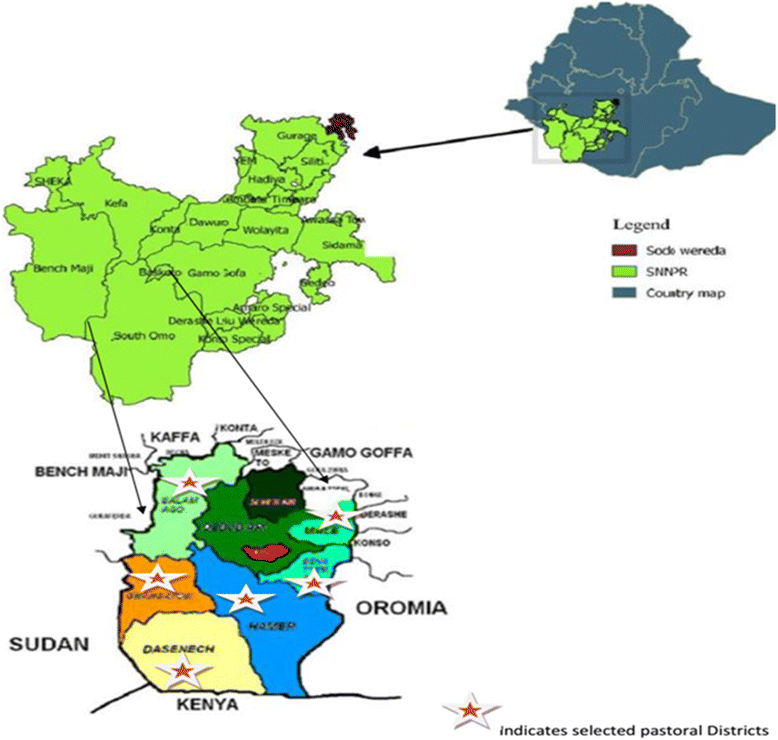Latent tuberculosis infection and associated risk indicators in pastoral communities in southern Ethiopia: a community based cross-sectional study
- PMID: 29454325
- PMCID: PMC5816385
- DOI: 10.1186/s12889-018-5149-7
Latent tuberculosis infection and associated risk indicators in pastoral communities in southern Ethiopia: a community based cross-sectional study
Abstract
Background: Research pertaining to the community-based prevalence of latent tuberculosis infection (LTBI) is important to understand the magnitude of this infection. This study was conducted to estimate LTBI prevalence and to identify associated risk factors in the Omo Zone of Southern Ethiopia.
Methods: A community-based cross-sectional study was conducted in six South Omo districts from May 2015 to February 2016. The sample size was allocated to the study districts proportional to their population sizes. Participants were selected using a multi-stage sampling approach. A total of 497 adult pastoralists were recruited. Blood samples were collected from the study participants and screened for LTBI using a U.S. Food and Drug Administration approved interferon-gamma release assay (IGRA). Logistic regression was used to model the likelihood of LTBI occurrence and to identify risk factors associated with LTBI.
Results: The prevalence of LTBI was 50.5% (95% CI: 46%, 55%) with no significant gender difference (49.8% among males versus 51.2% among females; Chi-square (χ2) = 0.10; P = 0.41) and marginally non-significant increasing trends with age (44.6% among those below 24 years and 59.7% in the age range of 45-64 years; χ2 = 6.91; P = 0.075). Being residence of the Dasanech District (adjusted odds ratio, AOR = 2.62, 95% CI: 1.30, 5.28; P = 0.007) and having a habit of eating raw meat (AOR = 2.89, 95% CI: 1.09, 7.66; P = 0.033) were significantly associated with an increased odds of being positive for LTBI. A large family size (size of 5 to 10) has significant protective effect against associated a reduced odds of being positive for LTBI compared to a family size of below 5 (AOR = 0.65, 95% CI: 0.42, 0.99; P = 0.045).
Conclusions: A high prevalence of LTBI in the South Omo Zone raises the concern that elimination of TB in the pastoral communities of the region might be difficult. Screening for and testing individuals infected with TB, independent of symptoms, may be an effective way to minimize the risk of disease spread.
Keywords: Ethiopia; IGRA; LTBI; Prevalence; South Omo.
Conflict of interest statement
Competing interest
The authors declare that they have no competing interests.
Ethics approval and consent to participate
Ethical approval for the study was obtained from Addis Ababa University, Aklilu Lemma Institute of Pathobiology Research and Ethics Committee as well as from the National Ethics Committee of Ethiopia (Ref No:3.10/785/07). Written consent was obtained from each study participant after a clear explanation of the study objectives and potential health and patient data confidentiality risks. Blood sample collection was undertaken under aseptic conditions by licensed medical laboratory professionals. Volunteer individuals with any sign and symptom of active TB or any other diseases during data collection time were transported by project expense to nearby health facilities to undertake complete examination. Individuals who had LTBI were advised to consult their nearby health facilities.
Consent for publication
Not applicable
Publisher’s Note
Springer Nature remains neutral with regard to jurisdictional claims in published maps and institutional affiliations.
Figures
Similar articles
-
Prevalence of latent tuberculosis infection and associated risk factors in prison in East Wollega Zone of western Ethiopia.PLoS One. 2020 May 19;15(5):e0233314. doi: 10.1371/journal.pone.0233314. eCollection 2020. PLoS One. 2020. PMID: 32428042 Free PMC article.
-
Community-based cross-sectional survey of latent tuberculosis infection in Afar pastoralists, Ethiopia, using QuantiFERON-TB Gold In-Tube and tuberculin skin test.BMC Infect Dis. 2011 Apr 9;11:89. doi: 10.1186/1471-2334-11-89. BMC Infect Dis. 2011. PMID: 21477326 Free PMC article.
-
Prevalence of Mycobacterium tuberculosis infection as measured by the QuantiFERON-TB Gold assay and ESAT-6 free IGRA among adolescents in Mwanza, Tanzania.PLoS One. 2021 Jun 7;16(6):e0252808. doi: 10.1371/journal.pone.0252808. eCollection 2021. PLoS One. 2021. PMID: 34097715 Free PMC article.
-
Comparing the cost-effectiveness of two screening strategies for latent tuberculosis infection in Portugal.Pulmonology. 2021 Nov-Dec;27(6):493-499. doi: 10.1016/j.pulmoe.2021.04.002. Epub 2021 May 27. Pulmonology. 2021. PMID: 34053903 Review.
-
Accuracy of interferon-γ-induced protein 10 for diagnosing latent tuberculosis infection: a systematic review and meta-analysis.Clin Microbiol Infect. 2019 Jun;25(6):667-672. doi: 10.1016/j.cmi.2018.12.006. Epub 2018 Dec 14. Clin Microbiol Infect. 2019. PMID: 30553864
Cited by
-
Interferon Gamma Release Assay and Tuberculin Skin Test Performance in Pregnant Women Living With and Without HIV.J Acquir Immune Defic Syndr. 2022 Jan 1;89(1):98-107. doi: 10.1097/QAI.0000000000002827. J Acquir Immune Defic Syndr. 2022. PMID: 34629414 Free PMC article.
-
Intestinal Helminth Infections and Their Association with QuantiFERON-TB Gold Plus Test Performance in an Endemic Setting, Northwest Ethiopia.Infect Drug Resist. 2024 Oct 17;17:4487-4500. doi: 10.2147/IDR.S476492. eCollection 2024. Infect Drug Resist. 2024. PMID: 39435458 Free PMC article.
-
Magnitude, associated risk factors, and trend comparisons of identified tuberculosis types among prisons in Ethiopia: A systematic review and meta-analysis.Health Sci Rep. 2024 Jan 4;7(1):e1789. doi: 10.1002/hsr2.1789. eCollection 2024 Jan. Health Sci Rep. 2024. PMID: 38186928 Free PMC article.
-
Co-infection mathematical model for HIV/AIDS and tuberculosis with optimal control in Ethiopia.PLoS One. 2024 Dec 10;19(12):e0312539. doi: 10.1371/journal.pone.0312539. eCollection 2024. PLoS One. 2024. PMID: 39656715 Free PMC article.
-
Milk and meat consumption patterns and the potential risk of zoonotic disease transmission among urban and peri-urban dairy farmers in Ethiopia.BMC Public Health. 2022 Feb 3;22(1):222. doi: 10.1186/s12889-022-12665-4. BMC Public Health. 2022. PMID: 35114957 Free PMC article.
References
-
- WHO. Global tuberculosis report 2017. WOH. 2017. Geneva: WHO/HTM/TB/2017.23.
-
- WHO. The End TB strategy: Guidelines on the management of latent tuberculosis. WHO. 2015. Geneva: WHO/HTM/TB 2015.01.
Publication types
MeSH terms
Grants and funding
LinkOut - more resources
Full Text Sources
Other Literature Sources


